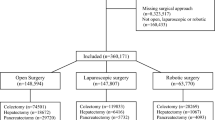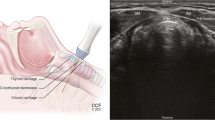Abstract
Purpose of Review
The goal of this article is to review the current role of robotic urologic surgery in the infant population across a spectrum of diseases and procedures.
Recent Findings
Robotic urological surgery has been performed in the infant population across a variety of conditions including ureteropelvic junction obstruction, vesicoureteral reflux, and duplicated and nonfunctional renal moieties. However, most of the durable evidence showing safety and success remains in the repair of the obstructed ureteropelvic junction. Included in this review are also strategies to address the limitations imposed by the unique physiology and anatomy of the infant.
Summary
Robotic urologic surgery remains an alternative to other surgical approaches in the properly selected infant in the hands of experienced surgeons. As additional larger studies are performed, the utility of the robotic platform in this population will be clearer.
Similar content being viewed by others
References
Papers of particular interest, published recently, have been highlighted as: • Of importance
Terrier G. Anaesthesia for laparoscopic procedures in infants and children: indications, intra- and post-operative management, prevention and treatment of complications. Curr Opin Anaesthesiol. 1999;12:311–4.
Bozkurt P, Kaya G, Yeker Y, Tunali Y, Altintaş F. The cardiorespiratory effects of laparoscopic procedures in infants. Anaesthesia. 1999;54(9):831–4.
Sureka SK, Patidar N, Mittal V, Kapoor R, Srivastava A, Kishore K, et al. Safe and optimal pneumoperitoneal pressure for transperitoneal laparoscopic renal surgery in infant less than 10 kg, looked beyond intraoperative period: A prospective randomized study. J Pediatr Urol. 2016;12(5):281.e1–7.
Olsen M, Avery N, Khurana S, Laing R. Pneumoperitoneum for neonatal laparoscopy: How safe is it? Paediatr Anaesth. 2013;23(5):457–9.
Tomaszewski JJ, Casella DP, Turner RM 2nd, Casale P, Ost MC. Pediatric laparoscopic and robot-assisted laparoscopic surgery: technical considerations. J Endourol. 2012;26:602–13.
Blinman T, Ponsky T. Pediatric minimally invasive surgery: laparoscopy and thoracoscopy in infants and children. Pediatrics. 2012;130(3):539–49.
Kaynan AM, Winfield HN. Thermostasis during laparoscopic urologic surgery. J Endourol. 2002;16(7):465–70.
Bharadwaj A, Khandelwal M, Bhargava SK. Perioperative neonatal and paediatric blood transfusion. Indian J Anaesth. 2014;58(5):652–7.
Howe A, Kozel Z, Palmer L. Robotic surgery in pediatric urology. Asian J Urol. 2016;4(1):55–67.
Roberts KB. Revised AAP Guideline on UTI in febrile infants and young children. Am Fam Physician. 2012;86(10):940–6.
Akhavan A, Merguerian PA, Larison C, Goldin AB, Shnorhavorian M. Trends in the rates of pediatric pyeloplasty for ureteropelvic junction obstruction over 19 years: a PHIS database study. Adv Urol. 2014;2014:142625.
Dangle PP, Kearns J, Anderson B, Gundeti MS. Outcomes of infants undergoingrobot-assisted laparoscopic pyeloplasty compared to open repair. J Urol. 2013;190(6):2221–6.
• Baek M, Silay MS, Au JK, et al. Does the use of 5 mm instruments affect the outcomes of robot-assisted laparoscopic pyeloplasty in smaller working spaces? A comparative analysis of infants and older children. J Pediatr Urol. 2018;14(6):537.e1–6 This paper encourages others to try the 5 mm instruments for infant pyeloplasty. It helps to justify exploring different instruments which are traditionally seen as limited with poor utility.
Tröbs R-B, Reza VM, Grigore C. Transumbilical cord access (TUCA) for laparoscopy in infants and children: simple, safe and fast. Surg Today. 2016;46:235–40.
Yanke BV, Horowitz M. Safety of the Veress needle in pediatric laparoscopy. J Endourol. 2007;21(7):695–7.
Peters CA. Complications in pediatric urological laparoscopy: results of a survey. J Urol. 1996;155(3):1070–3.
Gupta R, Singh S. Challenges in paediatric laparoscopic surgeries. Indian J Anaesth. 2009;53(5):560–6.
Chang C, Steinberg Z, Shah A, Gundeti MS. Patient positioning and port placement for robot-assisted surgery. J Endourol. 2014;28(6):631–8.
Kawal T, Srinivasan AK, Shrivastava D, Chu DI, Van Batavia J, Weiss D, et al. Pediatric robotic-assisted laparoscopic pyeloplasty: Does age matter? J Pediatr Urol. 2018;14(6):540.e1–6.
• Finkelstein JB, Levy AC, Silva MV, Murray L, Delaney C, Casale P. How to decide which infant can have robotic surgery? Just do the math. J Pediatr Urol. 2015;11:170.e1–4 This article can help robotic surgeons select which patients may be more challenging robotically. It may make patient selection more precise preoperatively.
Cost NG, Lee J, Snodgrass WT, Harrison CB, Wilcox DT, Baker LA. Hernia after pediatric urological laparoscopy. J Urol. 2010;183(3):1163–7.
Tapscott A, Kim SS, White S, Graves R, Kraft K, Casale P. Port-site complications after pediatric urologic robotic surgery. J Robot Surg. 2009;3(3):187.
• Avery DI, Herbst KW, Lendvay TS, Noh PH, Dangle P, Gundeti MS, et al. Robot-assisted laparoscopic pyeloplasty: multi-institutional experience in infants. J Pediatr Urol. 2015;11(3):139.e1–5 This study is one of the largest robotic series which includes the infant population. It shows feasibility in this population with comparable success rates to other approaches.
Kutikov A, Nguyen M, Guzzo T, Canter D, Casale P. Robot assisted pyeloplasty in the infant-lessons learned. J Urol. 2006;176(5):2237–9 discussion 2239–40.
Kassite I, Braik K, Villemagne T, Lardy H, Binet A. The learning curve ofrobot-assisted laparoscopic pyeloplasty in children: a multi-outcome approach. J Pediatr Urol. 2018;14(6):570.e1–570.e10.
Wiestma AC, Cho PS, Hollis MV, Badway J, Yu RN. Robot-assisted laparoscopic lower pole partial nephrectomy in the pediatric patient. J Pediatr Urol. 2016;12(6):428–9.
Lee RS, Sethi AS, Passerotti CC, Peters CA. Robot-assisted laparoscopic nephrectomy and contralateral ureteral reimplantation in children. J Endourol. 2010;24(1):123–8.
Bansal D, Cost NG, Bean CM, Vanderbrink BA, Schulte M, Noh PH. Infant robot-assisted laparoscopic upper urinary tract reconstructive surgery. J Pediatr Urol. 2014;10(5):869–74.
Biles MJ, Finkelstein JB, Silva MV, Lambert SM, Casale P. Innovation in robotics and pediatric urology: robotic ureteroureterostomy for duplex systems with ureteral ectopia. J Endourol. 2016;30(10):1041–8.
Lee NG, Corbett ST, Cobb K, Bailey GC, Burns AS, Peters CA. Bi-institutional comparison of robot-assisted laparoscopic versus open ureteroureterostomy in the pediatric population. J Endourol. 2015;29(11):1237–41.
Chaudhry R, Stephany HA. Robotic ureteral reimplant-the current role. CurrUrol Rep. 2017;18(4):30.
Garcia-Roig M, Travers C, McCracken CE, Kirsch AJ. National trends in the management of primary vesicoureteral reflux in children. J Urol. 2018;199(1):287–93.
Grimsby GM, Dwyer ME, Jacobs MA, Ost MC, Schneck FX, Cannon GM, et al. Multi-institutional review of outcomes of robot-assisted laparoscopic extravesical ureteral reimplantation. J Urol. 2015;193(5 Suppl):1791–5.
Author information
Authors and Affiliations
Corresponding author
Ethics declarations
Conflict of Interest
Jeffrey Villanueva, Mary Killian, and Rajeev Chaudhry each declare no potential conflicts of interest.
Human and Animal Rights and Informed Consent
This article does not contain any studies with human or animal subjects performed by any of the authors.
Additional information
Publisher’s Note
Springer Nature remains neutral with regard to jurisdictional claims in published maps and institutional affiliations.
This article is part of the Topical Collection on Pediatric Urology
Rights and permissions
About this article
Cite this article
Villanueva, J., Killian, M. & Chaudhry, R. Robotic Urologic Surgery in the Infant: a Review. Curr Urol Rep 20, 35 (2019). https://doi.org/10.1007/s11934-019-0902-8
Published:
DOI: https://doi.org/10.1007/s11934-019-0902-8




